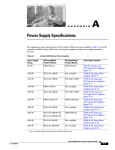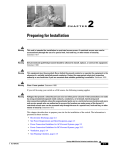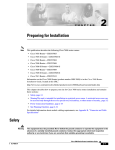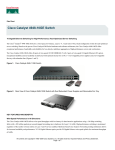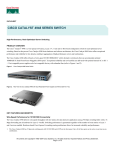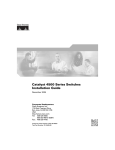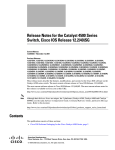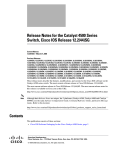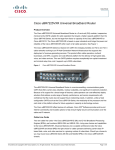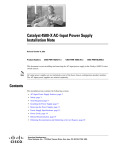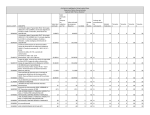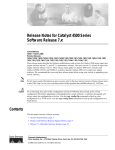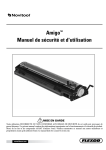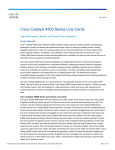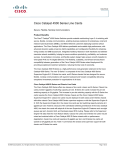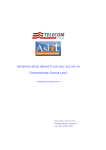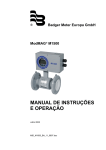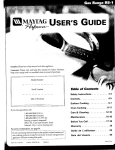Download IronPort Systems 4500 Series User's Manual
Transcript
C H A P T E R 2 Preparing for Installation Warning This unit is intended for installation in restricted access areas. A restricted access area can be accessed only through the use of a special tool, lock and key, or other means of security. Statement 1017 Warning Only trained and qualified personnel should be allowed to install, replace, or service this equipment. Statement 1030 Warning This equipment must be grounded. Never defeat the ground conductor or operate the equipment in the absence of a suitably installed ground conductor. Contact the appropriate electrical inspection authority or an electrician if you are uncertain that suitable grounding is available. Statement 1024 Warning Class 1 laser product. Statement 1008 Catalyst 4500 Series Switches Installation Guide 78-14409-08 2-1 Chapter 2 Preparing for Installation Electrostatic Discharge If you will be using your switch as a PoE source, the following warning applies: Warning Voltages that present a shock hazard can exist on inline power circuits if interconnections are made by using uninsulated exposed metal contacts, conductors, or terminals. Avoid using such interconnection methods unless the exposed metal parts are in a restricted access location and users and service people who are authorized to access the location are made aware of the hazard. A restricted access area can be accessed only through the use of a special tool, lock and key, or other means of security. Statement 1072 This chapter describes how to prepare your site for the installation of the switch. The information is presented in these sections: Note • Electrostatic Discharge, page 2-2 • Site Power Requirements and Heat Dissipation, page 2-4 • Power Connection Guidelines for AC-Powered Systems, page 2-5 • Site-Planning Checklist, page 2-16 See the Site-Planning Checklist at the end of this chapter to help ensure that you complete all site-planning activities before you install the switch. Electrostatic Discharge Electrostatic discharge is common on Category 5E and Category 6 cabling systems. Category 5E and Category 6 cables have higher capacitance than Category 5 cables. As a result, Category 5E and Category 6 cables can store higher voltages than Category 5 cables and are more prone to damaging networking equipment if a differential discharge event occur. Unshielded twisted-pair cables can store high voltages. When these charged cables are connected to networking equipment, energy is discharged into the networking equipment; this is known as electrostatic discharge (ESD). Networking equipment is commonly designed and tested to withstand common mode ESD events of up to 2000 V. The design for the common mode event is based on the expectation that the discharge is delivered to all pins of a port at once. Catalyst 4500 Series Switches Installation Guide 2-2 78-14409-08 Chapter 2 Preparing for Installation Electrostatic Discharge Sometimes, voltage is discharged to some of the pins of the connector and not others, or to some pins on the connector before others. This is known as a differential discharge event, which can damage the networking equipment being connected. You can take the following measures to prevent ESD cable damage: • Ground the cable before connecting the networking equipment. You can create a grounding cable using an RJ-45 patch cable by doing the following: – Bare the wires on one end – Connect the wires to a suitable and safe earth ground – Connect the RJ-45 cable to a female RJ-45 connector • Briefly connect all cables to the grounded cable before connecting to networking equipment. • Leave cables from the networking equipment in the distribution closet connected to ports at user desktops. After you make connections on either side of the cable to networking equipment, the cable will not build up charge. Preventing Electrostatic Discharge Damage Electrostatic discharge (ESD) damage, which can occur when electronic cards or components are improperly handled, results in complete or intermittent failures. Port adapters and processor modules consist of printed circuit boards that are fixed in metal carriers. Electromagnetic interference (EMI) shielding and connectors are integral components of the carrier. Although the metal carrier helps to protect the board from ESD, use a preventive antistatic strap during handling. Following are guidelines for preventing ESD damage: • Always use an ESD wrist or ankle strap and ensure that it makes good skin contact. • Connect the equipment end of the strap to an unfinished chassis surface. • When installing a component, use any available ejector levers or captive installation screws toproperly seat the bus connectors in the backplane or midplane. These devices prevent accidentalremoval, provide proper grounding for the system, and help to ensure that bus connectors areproperly seated. Catalyst 4500 Series Switches Installation Guide 78-14409-08 2-3 Chapter 2 Preparing for Installation Site Power Requirements and Heat Dissipation Caution • When removing a component, use any available ejector levers or captive installation screws to release the bus connectors from the backplane or midplane. • Handle carriers by available handles or edges only; avoid touching the printed circuit boards or connectors. • Place a removed component board-side-up on an antistatic surface or in a static shielding container. If you plan to return the component to the factory, immediately place it in a static shielding container. • Avoid contact between the printed circuit boards and clothing. The wrist strap only protects components from ESD voltages on the body; ESD voltages on clothing can still cause damage. • Never attempt to remove the printed circuit board from the metal carrier. For safety, periodically check the resistance value of the antistatic strap. The measurement should be between 1 and 10 megohm (Mohm). Site Power Requirements and Heat Dissipation This section provides module power requirements and heat dissipation specifications for the Catalyst 4500 series switches. You should verify site power before you install the switch. For more information about power management and planning, refer to the “Environmental Monitoring and Power Management” chapter in the Catalyst 4500 Series Switch Cisco IOS Software Configuration Guide version appropriate for your software. Knowing the power requirements is useful for planning the power distribution system needed to support the switches. You should consider the heat dissipation specifications when estimating the air-conditioning requirements for an installation. For all Catalyst 4500 series switches, supervisor engines, and switching modules in AC or DC environments see the Catalyst 4500 Series Module Installation Guide at: http://www.cisco.com/univercd/cc/td/doc/product/lan/cat4000/hw_doc/mod_inst /0aspecs.htm#wp1012188. Catalyst 4500 Series Switches Installation Guide 2-4 78-14409-08 Chapter 2 Preparing for Installation Power Connection Guidelines for AC-Powered Systems Power Connection Guidelines for AC-Powered Systems This section provides guidelines for connecting the Catalyst 4500 series switch AC power supplies to the site power source. Basic guidelines include the following: • Make sure each chassis power supply has its own dedicated branch circuit. • Size the circuits according to local and national codes. • If you are using a 200/240 VAC power source in North America, use a two-pole circuit breaker to protect the circuit. • Place the source AC outlet within 6 feet (1.8 meters) of the system and make sure it is easily accessible. • Make sure the AC power receptacles used to plug in the chassis are the grounding type. The grounding conductors that connect to the receptacles should connect to protective earth ground at the service equipment. Four types of AC-input power supplies are available: • 1000 W—Table 2-1 lists the AC-input power cord options, specifications, Cisco part numbers, and shows the different styles of 1000 W AC-input power cord wall plugs that are available for North America and international locations as well as the appliance coupler that is attached to the power supply end of the power cord. • 1300 W—Table 2-1 lists the AC-input power cord options, specifications, and Cisco product numbers, and shows the different styles of 1300 W AC-input power cord wall plugs that are available for North America or various international locations as well as the appliance coupler that is attached to the power supply end of the power cord. Note For North America, the power cord plug types and appliance couplers on the power supplies are different for the 1000 W power supplies and the 1300 W power supplies; for other countries, the plugs shown are the same for the 1000 W and 1300 W power supplies. Catalyst 4500 Series Switches Installation Guide 78-14409-08 2-5 Chapter 2 Preparing for Installation Power Connection Guidelines for AC-Powered Systems • 1400 W—Table 2-1 lists the AC-input power cord options, specifications, and Cisco product numbers, and shows the different styles of 1400 W AC-input power cord wall plugs that are available for North America or various international locations as well as the appliance coupler that is attached to the power supply end of the power cord. • 2800 W—Table 2-1 lists the AC-input power cord options, specifications, and Cisco part numbers, and shows the different styles of 2800 W AC-input power cord wall plugs that are available for North America and international locations as well as the appliance coupler that is attached to the other end of the 2800 W power supply power cord. • 4200 W—Table 2-1 lists the AC-input power cord options, specifications, and Cisco part numbers, and shows the different styles of 4200 W AC-input power cord wall plugs that are available for North America and international locations as well as the appliance coupler that is attached to the other end of the 4200 W power supply power cord. Table 2-1 AC-Input Power Cord Options Locale Part Number Length Plug Rating Plug Type 1000 W Power Supply (PWR-C45-1000AC=) 120352 Appliance Coupler 8.2 ft (2.5 m) 125 VAC, 15 A NEMA 5-15P Australia, New Zealand CAB-7KACA= 8.2 ft (2.5 m) 250 VAC, 15 A SAA/3, AS/NZS 3112-1993 Europe (except CAB-7KACE= Italy) 8.2 ft (2.5 m) 250 VAC, 16 A CEE 7/7 120357 120356 120354 North America CAB-7KAC= Catalyst 4500 Series Switches Installation Guide 2-6 78-14409-08 Chapter 2 Preparing for Installation Power Connection Guidelines for AC-Powered Systems Table 2-1 AC-Input Power Cord Options (continued) Locale Part Number Length Italy CAB-7KACI= 8.2 ft (2.5 m) 250 VAC, 16 A 1/3/16 CEI 23-16 United Kingdom CAB-7KACU= 8.2 ft (2.5 m) 250 VAC, 13 A BS 89/13 BS 1363/A Argentina CAB-7KACR= 8.2 ft (2.5 m) 250 VAC, 10 A IRAM 2073 Plug Type 120356 120359 120358 Plug Rating 120353 Appliance Coupler 1300 W (PWR-C45-1300ACV=) and 1400 W (PWR-C45-1400AC=) Power Supplies 14 ft (4.3 m) 125 VAC, 20 A NEMA 5-20 Australia, New Zealand CAB-7513ACA= 14 ft (4.3 m) 250 VAC, 15 A SAA/3, AS/NZZS 3112-1993 Europe (except CAB-7513ACE= Italy) 14 ft (4.3 m) 250 VAC, 16 A CEE 7/7 120357 120356 120362 North America CAB-7513AC= Catalyst 4500 Series Switches Installation Guide 78-14409-08 2-7 Chapter 2 Preparing for Installation Power Connection Guidelines for AC-Powered Systems AC-Input Power Cord Options (continued) Locale Part Number Length Plug Rating Plug Type Italy CAB-7513ACI= 14 ft (4.3 m) 250 VAC, 16 A 1/3/16, CEI 23-16 United Kingdom CAB-7513ACU= 14 ft (4.3 m) 250 VAC, 13 A BS 89/13 BS 1363/A Argentina CAB-7513ACR= 14 ft (4.3 m) 250 VAC, 10 A IRAM 2073 North America CAB-AC-2800W-TWLK= 13.6 ft (4.1 m) (locking) 200–240 VAC operation 250 VAC, 16 A NEMA L6-20 North America CAB-AC-2800W-6-20 (non-locking) 200–240 VAC operation 13.2 ft (4.0 m) 250 VAC, 16 A NEMA 6-20 non-locking Europe 13.2 ft (4.0 m) 250 VAC, 16 A CEE 7/7 120355 120357 CAB-AC-2800W-EU= 120361 120356 120359 120358 Table 2-1 Catalyst 4500 Series Switches Installation Guide 2-8 78-14409-08 Chapter 2 Preparing for Installation Power Connection Guidelines for AC-Powered Systems AC-Input Power Cord Options (continued) Locale Part Number Length Plug Rating Plug Type International CAB-AC-2800W-INT= 13.6 ft (4.1 m) 250 VAC, 16 A IEC 309 120360 Table 2-1 120353 Appliance Coupler 2800 W Power Supply (PWR-C45-2800ACV=) 250 VAC, 16 A NEMA L6-20 North America CAB-AC-2800W-6-20 (non-locking) 200–240 VAC operation 13.2 ft (4.0 m) 250 VAC, 16 A NEMA 6-20 non-locking Europe CAB-AC-2800W-EU= 13.2 ft (4.0 m) 250 VAC, 16 A CEE 7/7 International CAB-AC-2800W-INT= 13.6 ft (4.1 m) 250 VAC, 16 A IEC 309 120360 120357 120355 120361 North America CAB-AC-2800W-TWLK= 13.6 ft (locking) (4.1 m) 200–240 VAC operation Catalyst 4500 Series Switches Installation Guide 78-14409-08 2-9 Chapter 2 Preparing for Installation Power Connection Guidelines for AC-Powered Systems Table 2-1 AC-Input Power Cord Options (continued) Locale Part Number Length Plug Rating Plug Type 120353 Appliance Coupler 4200 W Power Supply (PWR-C45-4200ACV=) North America CAB-US515P-C19-US 9.8 ft (2.98 m) 125VAC, 15A NEMA 5-15P North America CAB-L620P-C19-US (locking) 200–240 VAC operation 14 ft (4.2 m) 250 VAC, 20 A NEMA L6-20 North America CAB-US620P-C19-US (non-locking) 200–240 VAC operation 13.2 ft (4.02 m) 250 VAC, 20 A NEMA 6-20 non-locking Europe CAB-CEE77-C19-EU 13.2 ft (4.0 m) 250 VAC, 15 A CEE 7/7 International (including Argentina and South Africa) CAB-I309-C19-INT 13.6 ft (4.1 m) 250 VAC, 16 A IEC 309 120360 120357 120355 120361 120354 120 VAC operation Catalyst 4500 Series Switches Installation Guide 2-10 78-14409-08 Chapter 2 Preparing for Installation Power Connection Guidelines for AC-Powered Systems AC-Input Power Cord Options (continued) Locale Part Number Length Plug Rating Plug Type Australia CAB-A3112-C19-AUS 14 ft (4.3 m) 250 VAC, 15 A AS/NZZS 3112 Italy CAB-C2316-C19-IT 14 ft (4.3 m) 250 VAC, 16 A CEI 23-16 United Kingdom CAB-BS1363-C19-UK 14 ft (4.3 m) 250 VAC, 15 A BS 1363 Israeli CAB-S132-C19-ISRL 14 ft (4.3 m) 250 VAC, 16 A SI32 UPS 220V CAB-C19-CBN 9 ft (2.74 m) 250 VAC, 20 A IEC-60320-C20 UPS 110V CAB-C19-C14 14 ft (4.3 m) 125 VAC, 16 A IEC-60320-C14 130924 130923 130922 120359 120358 120356 Table 2-1 Catalyst 4500 Series Switches Installation Guide 78-14409-08 2-11 Chapter 2 Preparing for Installation Power Connection Guidelines for DC-Powered Systems Power Connection Guidelines for DC-Powered Systems This section provides the basic guidelines for connecting the Catalyst 4500 series switch DC-input power supplies to the site power source or AC power shelf: • All power connection wiring should conform to local and national codes. • DC (–) and DC return (+) terminals are evaluated for use with 1/0 AWG wire (1400W DC supply only). • The ground terminal is evaluated for use with 6 AWG wire (10 AWG for the multi-input power supply). • DC (–) and DC return (+) wire lugs shall not exceed 0.83 inches in width (0.378 inches for the multi-input power supply). • For DC power cables, we recommend that you use commensurately rated, high-strand-count copper wire cable. Connection to the DC-input power supply requires one earth ground cable, one source DC (–), and one source DC return (+). The length of the cables depends on your switch location. These cables are not available from Cisco Systems. They are available from any commercial cable vendor. • The color coding of the source DC power cable leads depends on the color coding of the site DC power source. Typically, green or green and yellow indicate that the cable is a ground cable. Because there is no color code standard for source DC wiring, you must ensure that the power cables are connected to the DC-input power supply terminal block in the proper (+) and (–) polarity. In some cases, the source DC cable leads might have a positive (+) or a negative (–) label. This label is a relatively safe indication of the polarity, but you must verify the polarity by measuring the voltage between the DC cable leads. When making the measurement, the positive (+) lead and the negative (–) lead must always match the (+) and (–) labels on the DC-input power supply terminal block. Catalyst 4500 Series Switches Installation Guide 2-12 78-14409-08 Chapter 2 Preparing for Installation Power Connection Guidelines for DC-Powered Systems Calculating DC Input Current Complete power usage tables are in the Catalyst 4500 Series Module Installation Guide. To calculate the DC input current needed for data and inline power applications, use the following steps (the example shows the DC input current requirement in a Catalyst 4503 with a Supervisor Engine II and two WS-X4306-GB modules, and assumes a DC input voltage of -48 VDC): Step 1 Step 2 Add the power requirement for each component in your system. • Catalyst 4503 uses 54 W • Supervisor Engine II uses 147 W • WS-X4306-GB uses 2 X 47 = 94 W • Total DC input power = 295 W After the entries for all components have been added together, divide that number by the DC input voltage to determine the DC input current. • Input current = 295 W/48 VDC = 6.14 A for data only. Step 3 to Step 5 are for applications requiring inline power. If your configuration does not include inline power devices, the DC input current is the result of Step 2. Step 3 If you want to add an inline-capable module (WS-X4148-RJ45V) with 10 inline devices (such as IP Phones) to your system, calculate the DC output power sent to inline devices. • 10 X 6.3 W = 63 W for inline devices. 6.3 Watts is correct for a Cisco IP phone. Wattage consumption will depend on the inline device used. Step 4 Find the DC input power using the DC output power. • Step 5 63/.96 (efficiency) = 65 W of DC input power. Divide the DC input power by the DC voltage input of –48 V to find the DC input current used by inline devices. • 65/48 = 1.4 Amps for inline devices. Catalyst 4500 Series Switches Installation Guide 78-14409-08 2-13 Chapter 2 Preparing for Installation Ventilation Step 6 Add the DC input current used by data and the DC input current used by inline devices to find the total DC input current. • Total DC input current = 6.14 + 1.4 = 7.54 A. Ventilation Planning a proper location for the switch and the layout of your equipment rack or wiring closet is essential for successful system operation. You should install the switch in an enclosed, secure area, ensuring that only qualified personnel have access to the switch and control of the environment. Equipment placed too close together or inadequately ventilated can cause system overtemperature conditions. In addition, poor equipment placement can make chassis panels inaccessible and difficult to maintain. The switch operates as a standalone system mounted in a rack in a secure wiring closet. It requires a dry, clean, well-ventilated, and air-conditioned environment. To ensure normal operation, maintain ambient airflow. If the airflow is blocked or restricted, or if the intake air is too warm, an overtemperature condition can occur. The switch environmental monitor can then shut down the system to protect the system components. To ensure normal operation and avoid unnecessary maintenance, plan your site configuration and prepare your site before installation. After installation, make sure the site maintains an ambient temperature of 0 to 40ºC (32 to 104ºF). It is essential to keep the area around the chassis as free from dust and foreign conductive material (such as metal flakes from nearby construction activity) as is possible. Multiple switches can be rack-mounted with little or no clearance above and below the chassis. However, when mounting a switch in a rack with other equipment, or when placing it on the floor near other equipment, ensure that the exhaust from other equipment does not blow into the intake vent of the chassis. Cooling air is drawn in through the right side of the chassis. Keep the right side clear of obstructions, including dust and foreign conductive material, and away from the exhaust ports of other equipment. Catalyst 4500 Series Switches Installation Guide 2-14 78-14409-08 Chapter 2 Preparing for Installation Ventilation Appendix A, “Specifications,” lists the operating and nonoperating environmental site requirements for the switches. To maintain normal operation and ensure high system availability, maintain an ambient temperature and clean power at your site. The environmental ranges listed in Appendix A, “Specifications,” are those within which the switch will continue to operate; however, a measurement that approaches the minimum or maximum of a range indicates a potential problem. You can maintain normal operation by anticipating and correcting environmental anomalies before they exceed the maximum operating range. Calculating System Heat Dissipation To calculate the expected heat dissipation from a switch, add the total amount of power drawn from power supply by the system's configuration, then divide the total amount of power by the efficiency of the power supply. Multiply the result by 3.415 to get the system heat dissipation in BTUs/hr. First example (System without any powered devices): Components Output Power 1 - Catalyst 4506 with fans 50 W 1 - Supervisor Engine IV 145 W 1 - WS-X4248-RJ45V with no phones 72 W total output power 267 W Total heat dissipated by system = (267/.75) * 3.415 = 1215 BTUs/hr Note All Catalyst 4000/4500 power supplies have different efficiencies, An average efficiency figure of 75% was chosen. Second example (same system but this time with one IEEE class 3 device): Components Output Power 1 - Catalyst 4506 with fans 50 W 1 - Supervisor Engine IV 145 W 1 - WS-X4248-RJ45V with no phones 72 W Catalyst 4500 Series Switches Installation Guide 78-14409-08 2-15 Chapter 2 Preparing for Installation Site-Planning Checklist 1 - IEEE class 3 device 17.3 W total output power 284 W Total heat dissipated by system = (284/.75) * 3.415 = 1293 BTUs/hr Note Although a class 3 device needs 15.4 W to power up, 17.3 W need to be generated from the backplane in order to have 15.4 W at the switch port. 17.3 W comes from the WS-X4248-RJ45V DC-DC converter’s efficiency (89%). Site-Planning Checklist Table 2-2 lists the site-planning activities that you should complete before you install a Catalyst 4500 series switch. Completing each activity helps to ensure a successful switch installation. Table 2-2 Site-Planning Checklist Task No. Planning Activity 1 Space evaluation: 2 • Space and layout • Floor covering • Impact and vibration • Lighting • Maintenance access Verified by Time Date Environmental evaluation: • Ambient temperature • Humidity • Altitude • Atmospheric contamination • Airflow Catalyst 4500 Series Switches Installation Guide 2-16 78-14409-08 Chapter 2 Preparing for Installation Site-Planning Checklist Table 2-2 Site-Planning Checklist (continued) Task No. Planning Activity 3 Power evaluation: 4 Verified by • Input power type • Receptacle proximity to the equipment • Dedicated (separate) circuits for redundant power supplies • UPS for power failures Time Date Grounding evaluation: • 5 Circuit breaker size Cable and interface equipment evaluation: 6 • Cable type • Connector type • Cable distance limitations • Interface equipment (transceivers) EMI evaluation: • Distance limitations for signaling • Site wiring • RFI levels Catalyst 4500 Series Switches Installation Guide 78-14409-08 2-17 Chapter 2 Preparing for Installation Site-Planning Checklist Catalyst 4500 Series Switches Installation Guide 2-18 78-14409-08


















